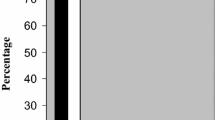Abstract
Background
Current knowledge about the blood supply of the nipple–areola complex (NAC) has largely been derived from studies on cadavers or persons with breasts of normal size. The aim of this study was to identify and classify the NAC blood supply by computed tomographic angiography (CTA) examination in female volunteers with breast hypertrophy.
Methods
CTA examination was performed on hypertrophic breasts of 23 female subjects. The main blood supplies were revealed through image data analyses. The dominant blood supply of the NAC and its vascular sources were identified and sorted. The detectable diameter threshold of blood vessels was set beyond 1.0 mm.
Results
A total of 61 dominant blood vessels were identified. The source arteries were traced as the internal thoracic artery (ITA, 50.8%), lateral thoracic artery (LTA, 27.8%), thoracoacromial artery (TA, 14.8%), brachial artery (BA, 3.3%), and axillary artery (AA, 3.3%), and the corresponding reproducibility of these source vessels was 31, 37, 9, 4.3, and 4.3%, in all breasts. The intercostal artery (IA) was not identified as a dominant NAC supplying vessel in any CTA scan image. Twenty-six breasts had only one dominant artery, whereas 17 breasts showed multiple dominant blood supplies. Three breasts showed no dominant blood vessels of the NAC, with diameters greater than the detectable threshold of 1.0 mm, and 52.2% of the breasts demonstrated anatomically symmetrical patterns of blood supply for the NAC.
Conclusions
The ITA, LTA, and TA are likely to be the main vessel sources, whereas the IA is unlikely to be the dominant vessel for NAC perfusion, on the basis of the studied breasts. An asymmetrical pattern of bilateral breast blood supply was demonstrated in a considerable portion of the females with breast hypertrophy in this study.
Level of Evidence IV
This journal requires that authors assign a level of evidence to each article. For a full description of these Evidence-Based Medicine ratings, please refer to the Table of Contents or the online Instructions to Authors www.springer.com/00266.



Similar content being viewed by others
References
Nakajima H, Imanishi N, Aiso S (1995) Arterial anatomy of the nipple-areola complex. Plast Reconstr Surg 96:843–845
van Deventer PV (2004) The blood supply to the nipple-areola complex of the human mammary gland. Aesthetic Plast Surg 28:393–398
O’Dey D, Prescher A, Pallua N (2007) Vascular reliability of nipple-areola complex-bearing pedicles: an anatomical microdissection study. Plast Reconstr Surg 119:1167–1177
Seitz IA, Nixon AT, Friedewald SM, Rimler JC, Schechter LS (2015) “NACsomes”: a new classification system of the blood supply to the nipple areola complex (NAC) based on diagnostic breast MRI exams. J Plast Reconstr Aesthet Surg 68:792–799
Cunningham L (1977) The anatomy of the arteries and veins of the breast. J Surg Oncol 9:71–85
Blondeel PN, Hamdi M, Van de Sijpe KA et al (2003) The latero-central glandular pedicle technique for breast reduction. Br J Plast Surg 56:348–359
O’Grady KF, Thoma A, Dal Cin A (2005) A comparison of complication rates in large and small inferior pedicle reduction mammaplasty. Plast Reconstr Surg 115:736–742
Nahabedian MY, McGibbon BM, Manson PN (2000) Medial pedicle reduction mammaplasty for severe mammary hypertrophy. Plast Reconstr Surg 105:896–904
Strauch B, Elkowitz M, Baum T, Herman C (2005) Superolateral pedicle for breast surgery: an operation for all reasons. Plast Reconstr Surg 115(1269–1277):1278–1279
Berthe JV, Massaut J, Greuse M, Coessens B, De Mey A (2003) The vertical mammaplasty: a reappraisal of the technique and its complications. Plast Reconstr Surg 111(2192–2199):2200–2202
Cardenas-Camarena L, Vergara R (2001) Reduction mammaplasty with superior-lateral dermoglandular pedicle: another alternative. Plast Reconstr Surg 107:693–699
Corduff N, Taylor GI (2004) Subglandular breast reduction: the evolution of a minimal scar approach to breast reduction. Plast Reconstr Surg 113:175–184
Keys KA, Louie O, Said HK, Neligan PC, Mathes DW (2013) Clinical utility of CT angiography in DIEP breast reconstruction. J Plast Reconstr Aesthet Surg 66:e61–e65
Pratt GF, Rozen WM, Chubb D et al (2012) Preoperative imaging for perforator flaps in reconstructive surgery: a systematic review of the evidence for current techniques. Ann Plast Surg 69:3–9
Teunis T, Heerma VVM, Kon M, van Maurik JF (2013) CT-angiography prior to DIEP flap breast reconstruction: a systematic review and meta-analysis. Microsurgery 33:496–502
Boschert MT, Barone CM, Puckett CL (1996) Outcome analysis of reduction mammaplasty. Plast Reconstr Surg 98:451–454
Gonzalez F, Walton RL, Shafer B, Matory WJ, Borah GL (1993) Reduction mammaplasty improves symptoms of macromastia. Plast Reconstr Surg 91:1270–1276
Setala L, Papp A, Joukainen S et al (2009) Obesity and complications in breast reduction surgery: are restrictions justified? J Plast Reconstr Aesthet Surg 62:195–199
Kreithen J, Caffee H, Rosenberg J et al (2005) A comparison of the LeJour and Wise pattern methods of breast reduction. Ann Plast Surg 54(236–241):241–242
Basaran K, Ucar A, Guven E et al (2011) Ultrasonographically determined pedicled breast reduction in severe gigantomastia. Plast Reconstr Surg 128:252e–259e
Anzidei M, Napoli A, Zaccagna F et al (2012) Diagnostic accuracy of colour Doppler ultrasonography, CT angiography and blood-pool-enhanced MR angiography in assessing carotid stenosis: a comparative study with DSA in 170 patients. Radiol Med 117:54–71
Acknowledgement
None of the authors has a financial interest in any of the products or devices mentioned in this article. This study was supported by the National Natural Science Foundation of China (81471884, 81671932), Natural Science Basic Research Plan in Shaanxi Province (2015JM8444), and Science and Technology Project of Shaanxi Province (2014k11-02-03-12). The authors thank each of their colleagues at the Institute of Plastic Surgery, Xijing Hospital, Fourth Military Medical University, for their full cooperation and support.
Author information
Authors and Affiliations
Corresponding author
Ethics declarations
Conflict of interest
All of the authors have no conflict of interest in this article.
Additional information
Hui Zheng and Yingjun Su have contributed equally to this research and should be viewed as co-first authors.
Rights and permissions
About this article
Cite this article
Zheng, H., Su, Y., Zheng, M. et al. Computed Tomographic Angiography-Based Characterization of Source Blood Vessels for Nipple–Areola Complex Perfusion in Hypertrophic Breasts. Aesth Plast Surg 41, 524–530 (2017). https://doi.org/10.1007/s00266-017-0791-5
Received:
Accepted:
Published:
Issue Date:
DOI: https://doi.org/10.1007/s00266-017-0791-5




